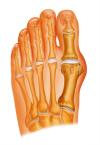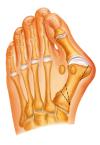|
Return to Articles Main Page
A bunion is an enlargement of bone at the big toe joint. It is usually characterized by deviation of the big toe either on top of or under the second toe. The term bunion is actually not a medical term but describes any enlargement behind the big toe. This could mean a simple enlargement or a bone that was moved out of position. The type of bunion a person has will determine the treatment option. Improper fitting shoes do not cause bunions, although that may worsen the deformity. Bunions are usually a result of the inherent bone structure of the foot and improper foot mechanics over a period of years.
Injuries to the joint or arthritis are other causes as well. Bunions are classified into two categories – positional or structural. However, many bunion deformities are a combination of both. |

|

|
POSITIONAL
This is where the large toe is pushed toward the next toe, as the bone enlarges. This changes the pull of the ligaments and tendons, causing misalignment of the joint.
STRUCTURAL
The results when the long bone behind the big toe is out of position when compared to the long bone behind the second toe. This causes the large toe to lean towards the second toe at a more acute angle. |
TREATMENT
A treatment plan for a bunion is made by a through examination of the foot. This may include testing of the motion of the joint, and the mechanics of the foot during walking. Weight-bearing x-rays should be taken to evaluate the bone structure and position.
Treatment is based on the amount of discomfort and the severity of the condition. Mild cases can be treated with shoe modifications or custom, molded inserts (orthotics) which modifies gait thereby helping to prevent improper movement of the bones in the foot.
Moderate to severe bunions usually necessitate surgery. In moderate cases, this may only involve removal of the enlarged bone with adjusting the ligaments. In more severe cases, a portion of the bone may need to be removed or shifted into better alignment. This procedure usually requires a pin or screw to be placed in the bone. Recovery time varies depending on the procedure to be performed. This could be anywhere from a few weeks to several months. Surgery to correct mild to moderate bunions will allow the patient to walk immediately following the procedure without a cast or crutches. In the more severe cases a cast and/or crutches would be necessary for four to six weeks. Most cases are corrected in an ambulatory surgical setting with intravenous sedation and local anesthesia.
Return to Articles Main Page
Our Services | Referring Physicians | About Us | Frequently Asked Questions | Blog | Articles
Surgical Animations | Links | News & Press | Photo Gallery
Contact Us | Home | Legal Notice | Privacy Statement | Site Map
Copyright © Buffalo Medical Group P.C. / Podiatry Affiliates
Website Design, Maintenance and Hosting by Catalyst Marketing / Worry Free Websites |
